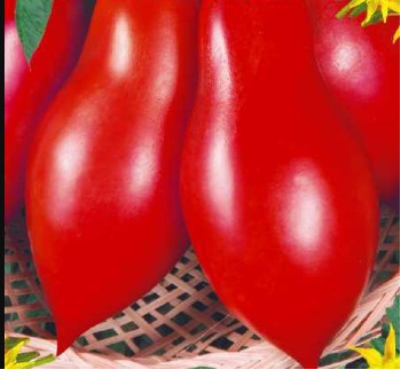
- Authors: Kudryavtseva G.A., Fotev Yu.V., Kotelnikova M.A., Kondakov S.N.
- Year of approval: 2008
- Category: grade
- Growth type: determinant
- Appointment: fresh consumption, for whole fruit preservation
- Ripening period: mid-early
- Ripening time, days: 104-108
- Growing conditions: for open ground, for film greenhouses
- Leaves: medium, green
- Unripe fruit color: light green
Inexperienced gardeners and farmers try to grow tomatoes on the plots that do not require complex agricultural technology, are endowed with strong immunity, grow in unfavorable conditions and give stable, high yields. These include the mid-early variety Siberian Pirouette.
Breeding history
The Siberian pirouette tomato is the creation of a group of Russian scientists (Kudryavtseva, Kotelnikova, Fotev and Kondakov), whose main task was to breed a nightshade crop that bears fruit under unfavorable conditions in regions with cool and short summers and risky farming. The species was bred in 2007. Included in the State Register of Breeding Achievements of Russia, and also allowed to use the tomato in 2008.
The plant can grow and bear fruit in almost all regions of the country - the Far Eastern, Central Black Earth, northern, Volgo-Vyatka, North Caucasian, Lower Volga, Ural and Central regions.
Description of the variety
The Siberian pirouette tomato is a low-growing plant of the determinant type, which grows up to 50-60 cm in height. Compact bushes have moderate thickening with green leaves, an erect central stem, medium branching, a developed root and simple inflorescences.
When growing, it is necessary to form bushes of 1-2 stems if the tomato grows in a garden bed, and 3-4 stems if in a film greenhouse. Despite its short stature, it is necessary to tie up the stem and branches by installing special supports or trellises. The only thing that does not need to be done is pinching, since new stepsons grow very slowly.
The purpose of the vegetable is universal - fresh consumption, canned and processed. The shape and size of the tomatoes allow for whole-fruit canning.
The main qualities of the fruit
The tomato belongs to the class of medium-fruited nightshade. The average weight of a vegetable is 65-70 grams. The shape of the fruit is cylindrical with a pronounced "nose" on one side and narrowing at the base. Ripe tomato is evenly covered with red, and at the stage of ripening it has a light green color without a darkened spot. The skin of the vegetable is quite dense, perfectly smooth and glossy.
The tomato is characterized by resistance to cracking, transportability and long shelf life (fresh tomatoes remain in the refrigerator for 3-4 weeks).
Taste characteristics
The tomato tastes excellent, which is confirmed by gardeners and experts. The flesh of the berry is dense, fleshy, juicy. A large number of seeds inside the tomato are not observed, as well as white veins. The classic sweet and sour taste is complemented by the pronounced tomato aroma present in many nightshades.
Ripening and fruiting
This type of tomato is medium early. From the mass germination of seedlings to the first ripe berries on the bushes, 104-108 days pass. Fruiting in a culture is long. The peak of fruiting occurs in July-August.
Yield
High-yielding variety. Subject to the minimum rules of agricultural technology, 6-6.5 kg of juicy tomatoes can be harvested from 1 m2 per season. It is worth noting that even when planting a tomato through sowing seeds in open ground, the yield is good.
The timing of planting seedlings and planting in the ground
Sowing seeds for seedlings is carried out in March. The seedlings are covered with polyethylene or glass, providing a greenhouse effect, which will accelerate germination. With an appropriate temperature regime (22-25 ° C) and sufficient lighting, seedlings appear on the 5-7th day.
At the stage of 2 leaves on a bush, you can dive plants in separate cups. A week before transferring to the garden bed, the culture is hardened, daily exposed to fresh air.
At the age of 60-65 days, the seedlings are transplanted to a permanent place of growth. At this stage, the plant should have 6-7 true leaves and 1 flower cluster. The transplant is carried out in the second half of May, when the air temperature has stabilized and the soil has warmed up. Seedlings are planted in the greenhouse several weeks earlier.

Growing tomato seedlings is an extremely important process, because it largely depends on whether the gardener can harvest at all. All aspects must be taken into account, from seedbed preparation to planting in the ground.
Landing scheme
When planting seedlings, it is imperative to take into account the density and planting pattern, since they are individual for each tomato species. 3-4 bushes grow comfortably per 1 m2. The recommended layout for planting is 40x40 cm.

Growing and caring
For tomatoes, you need an area with loose, fertile and moisture-absorbing soil, illuminated by the sun. Ideal is the soil where cabbage, carrots or cucumbers used to grow. The Siberian pirouette needs a comprehensive agricultural technique, which consists of watering, fertilizing, loosening the soil, forming and tying bushes, and preventive measures to protect against viruses.




A plant needs different micronutrients at each stage of growth. All fertilizers can be divided into two groups: mineral and organic. Folk remedies are often used: iodine, yeast, bird droppings, eggshells.
It is important to observe the rate and period of feeding. This also applies to folk remedies and organic fertilizers.
Disease and pest resistance
The culture has good immunity. Tomato is resistant to phytopathologies, but it can be exposed to phytophthora with excessive moisture.


Resistant to adverse weather conditions
The variety has a high resistance to stress, so the tomato grows well and bears fruit in case of sudden temperature jumps, heat and drought.

























































































